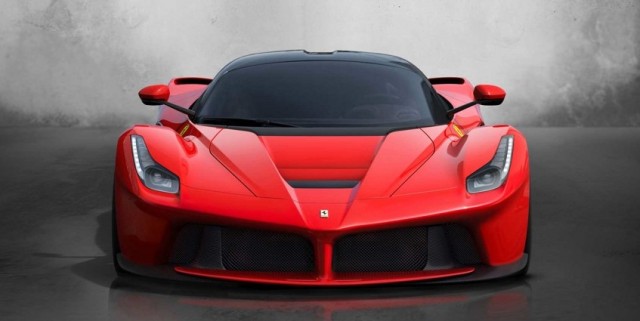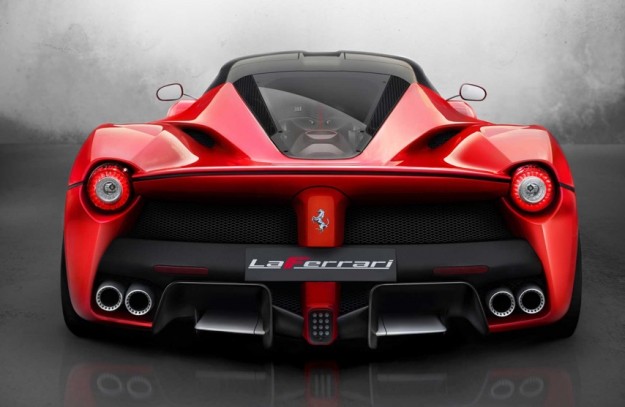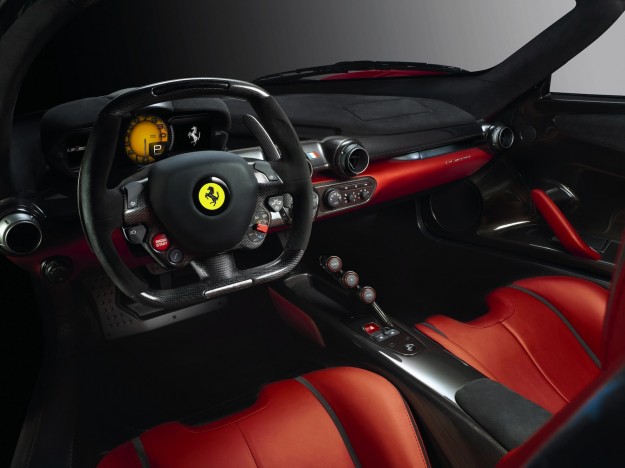
The fastest and most powerful Ferrari production car in history, the LaFerrari, has been unveiled at the 2013 Geneva motor show.
The latest in a long line of special series cars from the iconic Italian sports car manufacturer, the highly anticipated Ferrari Enzo replacement becomes the first to employ a hybrid drivetrain to deliver its record-shattering performance.
The LaFerrari teams a 588kW/700Nm 6.3-litre V12 engine with a Formula One-derived HY-KERS hybrid system to deliver a combined output of 708kW of power and in excess of 900Nm of torque.
A seven-speed dual-clutch transmission sends the power to the rear wheels, blasting the LaFerrari from 0-100km/h in less than three seconds, from 0-200km/h in under seven seconds, 0-300km/h in 15 seconds, and on to a top speed in excess of 350km/h.

The LaFerrari’s V12 engine revs to 9250rpm, which Ferrari says is a record for a unit of its displacement.
The hypercar’s hybrid system comprises two electric motors, one powering the driven wheels and the other applied to power ancillaries to take unnecessary strain off the engine.
The Scuderia Ferrari-developed battery pack is attached to the chassis floor, and with a total weight of just 60kg, claims to offer the highest energy density possible for its application.
The batteries are charged in two ways: under braking, and when the V12 produces more torque than is required, such as in cornering, with excess torque converted to energy rather than sent to the wheels.

Aiming to make the LaFerrari the most aerodynamically efficient road car ever created, Ferrari’s engineers honed the car’s design virtually before fine-tuning it in its F1 wind tunnel.
The LaFerrari incorporates active aerodynamics in the front diffusers and guide vane on the underbody as well as the rear diffusers and spoiler to generate additional downforce when required without compromising the car’s overall drag co-efficient.
Ferrari says the innovative integration of the LaFerrari’s active aerodynamics, hybrid system, Brembo brake package and other dynamic control systems creates a “seamless blend of unprecedented performance and unparalleled driving emotions”.

The Brembo system incorporates a number of new features, including new lightweight calipers designed to guarantee optimum cooling and carbon-ceramic discs made from a new composition measuring 398mm at the front and 380mm at the rear.
They sit within 19-inch alloys at the front and 20s at the rear, wrapped in Pirelli P Zero rubber with profiles of 265/30 and 345/30 respectively.
At 4702mm long, 1992mm wide, 1116mm tall and measuring 2650mm between the wheels, the LaFerrari is identical in length and wheelbase to the Enzo, as well as 43mm narrower and 31mm lower.

Four different types of hand-laminated, autoclave-cured carbonfibre are used in the LaFerrari’s chassis, with the lightweight material produced by the brand’s racing department using the same methods as the F1 cars. The result is a chassis with 27 per cent greater torsional rigidity and 22 per cent greater beam stiffness than its predecessor.
Inside the LaFerrari’s cabin, the driver’s seat is fixed and tailored to the owner, while the steering wheel and pedal box are both adjustable. Ferrari says F1 drivers Fernando Alsonso and Felipe Massa played an active role in the development process, leading to a driving position similar to that of a single-seater.
With its aces behind the wheel, Ferrari claims the LaFerrari is more than five seconds faster than the Enzo around its Fiorano test track, stopping the clock at 1:20.0, as well as being 20km/h faster down the main straight.

Ferrari president Luca di Montezemolo described the LaFerrari, which means ‘the Ferrari’, as the “maximum expression” of what defined the company: “excellence”.
“Excellence in terms of technological innovation, performance, visionary styling and the sheer thrill of driving,” Montezemolo said.
“Aimed at our collectors, this is a truly extraordinary car which encompasses advanced solutions that, in the future, will find their way onto the rest of the range, and it represents the benchmark for the entire automotive industry.
“LaFerrari is the finest expression of our company’s unique, unparalleled engineering and design know-how, including that acquired in Formula 1.”
Ferrari has confirmed it will produce 499 examples of the LaFerrari hypercar over the next two years. Its 1.3 million euro price tag makes it 20 per cent more expensive than its recently revealed rival, the McLaren P1, translating to an approximate Australian price of $2.5 million.





